what happened to the pink sidewalk in phoenix arizona
Esmé will ever remember June 26, 1990. People don't tend to forget days when their underpants literally melted due to the heat. The Valley resident was working at Sky Harbor International Drome equally a wardrobe artist on a commercial shoot for the at present-defunct America West Airlines.
It was a bad afternoon to be out on the tarmac. The temperature was unusually loftier, fifty-fifty for Phoenix: 120 degrees at 2 p.m. — and rising. The original plan was to motion picture inside the air-conditioned comforts of the final, and Esmé had shown up wearing an all-black ensemble: a long, sleeveless black linen clothes and sandals. But a last-minute alter sent them exterior in the blazing heat to shoot ground crews at work.
"I wound up sitting on an apple box on the tarmac for hours and hours watching them film people loading and unloading airplanes," Esmé says. "It got boring subsequently awhile."
But as the temperature kept ascension, things started to become more interesting.
"My sandals were stuck to the tarmac, and I walked right out of them," Esmé says.
She as well began feeling a burning sensation on her inner thighs.
"I idea, 'Oh my gosh, that really hurts.' I went to the ladies' room and the rubber effectually the leg band in my underwear completely melted. Completely melted. I had to pry it off my legs. I still take scars on my inner thighs to this solar day."

The pavement practically got molten on Phoenix'southward hottest day.
Sophy Smith
The temperature outside would eventually reach 122 degrees, a record hasn't been cleaved since. It was office of a miserable, weeklong heat wave in Arizona that — in addition to baking anybody's brains and giving transplants a reason to second-guess their decision to move here — resulted in dozens of hospitalizations and at least three deaths.
Phoenix earned headlines nationwide and was the butt of quips from late-dark TV talk show hosts. Valley meteorologists had a field twenty-four hours. Entrepreneurs made a fortune selling commemorative T-shirts within hours. Local utility Table salt River Project reported sky-high ability usage figures. A lot of people freaked out.
In some ways, it wasn't likewise dissimilar than the electric current COVID-nineteen pandemic: many Valley residents sheltered at dwelling or stayed inside out of harm's mode, while others refused to permit external factors like the heat keep them from having a good time.
As time passed, the events of the day made their way into local lore. "It was all people talked about for weeks," says Valley native Mick Welsh. "For the residue of that summer, everyone wouldn't shut up virtually it."
3 decades later — this week marks the 30th ceremony —Phoenicians however share tales, now often on social media, about exploding radiators, melted asphalt, and sunburns from hell that occurred on June 26, 1990. Some are true (people tried frying eggs outside), and others are simply hot air (like the ofttimes-repeated myth that Sky Harbor Aerodrome shut down that day).
We've rounded up a pick of memories from that mean solar day. They include quirky shenanigans, battles of homo versus nature, and a few tragedies. Here's that story, sunburns and all. (Some quotes accept been condensed and edited for brevity or clarity.)
6 a.m., 91 Degrees
Phoenix in late June 1990 was in the grip of a week-long heatwave. A large, high-pressure level atmospheric condition organization lingering over the Southwest resulted in a cord of 110 degree-plus days. On Mon, June 25, the Valley reached a record 120 degrees. Information technology didn't take long to meridian.
Doug Mummert, retired Phoenix Fire Department battalion primary: Information technology'd been very hot for a whole week. At that place were several days where we were breaking records, one after the other. When nosotros hit a record of 120 degrees, we thought that was a big deal.
Nancy Selover, Arizona Land climatologist: For eight days, we had this large, potent high-pressure ridge sitting on top of us. Very dry out air. No humidity, no clouds, nothing to suspension up the oestrus, and very little air current.

Onetime Aqueduct 12 meteorologist Ed Phillips in the late '80s/early '90s.
Ed Phillips
Ed Phillips, former meteorologist, Aqueduct 12 (KPNX-Idiot box): It's also called a subtropical high, and basically the center of it was right over us, and it just parked there and intensified. Heat can actually build up with time where everything gets a petty chip hotter each day.
Selover: We have a estrus island state of affairs here. All the pavement, concrete, or metallic [absorbs] all the heat and is slower to release dorsum into the air and literally takes all night to get out. And if you keep gaining rut each day, each night gets a little scrap warmer, and each morn yous're starting a little bit warmer. It'south cyclical. So at 6 a.grand. that morning, information technology was 91, because that was the most it could cool off since the night and solar day before were then hot and the pavement soaked everything up. And the temperature kept building from in that location.
Mick Welsh, former letter of the alphabet carrier: That part of summer, it actually doesn't absurd off at night at all. If you lot lived here, you'd know that. Yous'd get upwards and it'd be in the 90s.
Connie Hoy, former Valley resident: I was shooting a commercial for America West [Airlines] at the airport every bit an [assistant director] or production assistant. Just something for their new livery and some ground coiffure stuff. Our call was around 5 or half dozen a.m. or some ridiculously early on time. I was similar, "Summertime, meh." It didn't actually experience any different from the previous morning to me.
Welsh: I was a postal service carrier for 16 years and worked out of the Sierra Adobe station in northward Phoenix that day. Generally, the deeper we were into summer, the before we'd start. I remember going to the station at 4 a.m., spending the first two hours sorting post in a nice air-conditioned building, but I was out on the street at about 6. If you worked every bit a mail service carrier in Phoenix that twenty-four hour period, you definitely remember it.
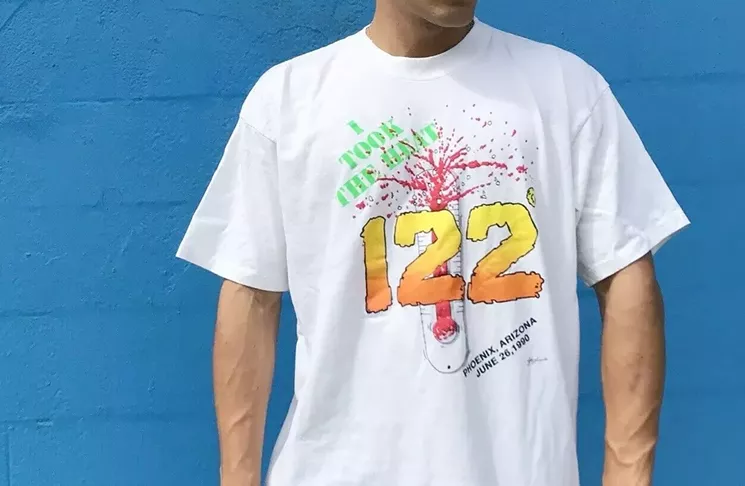
A commemorative T-shirt made past Rich Hazelwood's visitor in award of Phoenix's hottest twenty-four hour period. You can nonetheless discover 'em on eBay.
nine a.k., 105 Degrees
Equally the morning progressed, temperatures were rising fast. The thermometer had striking triple-digits by mid-morning. By apex, it was 116 degrees. Seeing this, one local entrepreneur got inspired.
Rich Hazelwood, owner, Hazelwoods Enterprises: I own souvenir shops across the country and a screen-printing visitor here. Nosotros'd get crazy ideas to do T-shirts for things in Phoenix, like the Pope'southward visit [in 1987] or the Phoenix Thousand Prix. My sales manager, Chuck Zootman, came to me around 9 o'clock that morning and said, "C'mon, we need to print something, this is gonna be a big deal." Because we'd already hit a record, he had a hunch. I said, "Okay, we need a design." So, Chuck got with some of the art guys and came upwards with a thermometer blowing up on the front. Nosotros started printing right away.
Chris McLennan, old employee, ARC Traders: We sold Rich beads and necklaces for his shops and he gave us T-shirts as cheers. He had some over that afternoon.
Hazelwood: We had to become them out in that location that day to strike while the fe was hot. I had them at all my stores, all my competitors' stores, and on street corners. Male child, I made a lot of money.
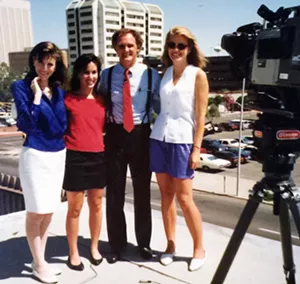
Meteorologist Dave Munsey, formerly of Play a trick on-10 (so known as KTSP), with interns atop of the station's edifice on June 26, 1990.
Dave Munsey
Dave Munsey, retired meteorologist, FOX ten (KSAZ-Goggle box): I wrote a volume [Munsey Business concern: 51 Years of Conditions, H2o Safety and Glory Interviews] with an entire chapter nearly that day. I mention something chosen the "11 Plus 10 Rule." You'd have the temperature at 11 a.m., add together 10 degrees and you'd pretty much go within a degree or ii of what the loftier would be. So I remember I got close.
Bruce Kelly, one-time radio deejay, Y-95 FM: That morning, my married woman and I were up in Pine, but we woke up, the kids were crying, nobody had slept because information technology was 106 and we had no Air conditioning. The Dude Burn northward of Payson was 3 miles from our house. We were similar, "We gotta get the fuck outta here." Nosotros were back [in Phoenix] by noon and ran right smack into the heat. It seemed like everybody was hiding somewhere, social distancing. In Arizona, that'south called the summer.
Welsh: I remember no one was on the street. No kids playing, no dogs, no one coming outside to greet me. I also kept burning my hand on those metal mailboxes, grabbing onto a piece of iron that'southward been baking in the sun all day. We had at least two people who our managers had to get and relieve because they'd passed out in someone'southward front end thousand.
Jerry Bradley, Phoenix resident: I used to be a City of Phoenix inspector for streets and construction. We were paving Thomas Road and I was continuing in betwixt a dozen trucks filled with 300-degree asphalt and all the rollers and pavers they were using. It got to the point where I'd gone through a gallon and a half of water and just kept on moving.
Peter Guercio, Queen Creek resident: I went with friends to Canyon Lake at 10 o'clock to get water-skiing and anywhere you touched metal on the boat, it was burn down. So kept rotating positions: i guy skiing, 1 guy on the back, and one driving. And we'd ski for really short stints, like five or 10 minutes. Everything was hot, even the water.
Patrick Thielbar, Phoenix Zoo employee: There used to be an outdoor basketball game court in the back of the zoo by our employee lounge. Nosotros'd usually play every 24-hour interval [equally] a lunchtime thing. We did that 24-hour interval, too; the oestrus didn't stop united states. Kind of like bragging rights, to say y'all played in that weather. But looking dorsum, it probably wasn't the smartest matter to do.
Bobbie Pendland, 60 minutes manager: I worked at a Taco Bell inside Paradise Valley Mall and we were selling more drinks and cold stuff than usual. In that location was a shaved water ice place beyond the food courtroom and they were doing phenomenal business. The line was ridiculous; I know because I wanted to send someone for one, and it was just too long.
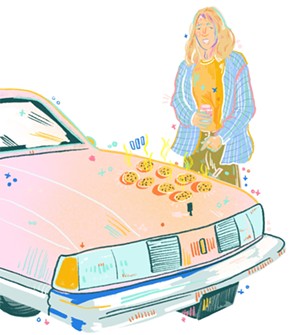
It was hot enough to bake cookies on a machine hood.
Sophy Smith
Rob Birmingham, bartender: I lived in Tempe at this wild apartment complex known every bit Desert Palms. Some asshole parked in my reserved parking spot, so I broiled some Cost House cookies on his car hood right effectually apex. By four p.m., the bottoms were pretty cooked. I was kinda hoping that the owner would come up out to encounter me eating one off of his ride.
David Mills, Phoenix resident: I was 15, on my twenty-four hours off from the Dairy Queen over on 19th Street and McDowell Road. They called me in since information technology was their busiest twenty-four hours always. The drive-thru was incredibly packed. There was a good xx to 30 people continuing in line at the counter. And everybody was ordering ice cream and Blizzards like crazy. Nosotros ran out of cones and dipping chocolate. The worst function was walking there. I was drenched in sweat by the time I got there. It was harsh, but it could've been worse. I tin can't imagine how many people lost their air-conditioning that solar day.
Samantha Kitts, IT security analyst: I was nigh 5 and we lost ability in our neighborhood around noon. Even with fans and misters on, information technology was similar 110 degrees inside our firm. We went to buy water ice and had to drive thirty minutes away because all the grocery stores and Walgreens were out. When nosotros came habitation, one of our bunny rabbits had died, so we started making ice baths for all our animals. If yous tin can imagine putting a cat in an ice bath, that's fun. Nosotros ended upwards losing both our rabbits and our republic of guinea pig. Yous couldn't really observe anywhere to cool off. Information technology was just oppressive.
Josh Roffler, senior curator, Tempe History Museum: I'd merely turned 15 and my family moved here from Idaho. Nosotros collection down from Flagstaff that solar day and it kept getting hotter and hotter, similar nosotros were arriving on some alien planet that was likewise close to the dominicus. Our car didn't have AC and it was a crushing, stifling heat that made it super-gluey. Our cats started panting badly with their tongues hanging out.
Mummert: On those days when the temperatures are extreme, in backlog of 110 [degrees], the [Phoenix Fire Department] sees a big uptick in calls for service for rut-related illnesses. That week, we had dozens of calls when temperatures were exceeding 120. Not but do we have sick people, just in the summertime we exercise have people who die from the oestrus.
Susan Ernst, Mesa resident: I was taking my kids to a moving-picture show in our station wagon [when] I heard an extremely loud "pop." It sounded like a gunshot, which I thought information technology was. I pulled off onto a side street, checked my kids to make sure they were okay and saw the driver'due south side drinking glass panel in the back had exploded outward. I recollect it was from the estrus buildup and having the air workout on high.
Lonnie Smalley, Phoenix resident: I was [driving] with my mom and nieces going down Baseline [Route]. We overheated and one of the water lines bankrupt. I ended up having to walk a mile and a one-half in that estrus to a Circumvolve Yard to telephone call for help while my mom and my nieces stayed with the car. We didn't have any money on u.s., so I had to call my dad collect and wait on him to come and become usa. I remember the [asphalt patching]. It was hot enough that I was sinking into information technology, like, an inch. I pulled my human foot up and information technology stuck to my shoes. It ruined my shoes.
Munsey: Effectually 1 o'clock, temperatures just kept going upward and upwardly and up. Every 15 minutes, it would shoot up. Information technology was 112, then 116, and when information technology hit 118, nosotros were in tape territory.
Phillips: Salt River Project also had a large 24-hour interval, as I recall.
Scott Harrelson, spokesperson, Table salt River Project: On that mean solar day, SRP set a new system peak tape of 3,373 megawatts.
Larry Crittenden, onetime spokesperson, Table salt River Projection: One matter that I remember is that [SRP was] buying excess power we could get from western states. Our traders were on the phone, two or 3 days in advance, to meet what we knew was going to be really high need. Nosotros'd made arrangements with some bigger customers [to reduce usage]. One big manufacturing facility might use as much power as a whole subdivision or more.
Only other than that, I don't recall u.s. having any brownouts or blackouts that directly attributed to the temperature extremes. That'due south not to say that we didn't take run-of-the-factory outages, where maybe a transformer fails and knocks off a few residential customers. It was an interesting couple of days.

An America West Airlines-owned 737 at Sky Harbor Airdrome in the '80s.
2 p.m., 122 Degrees
Phoenix officially smashed the rut record at 2:37 p.m. when the mercury reached 122 degrees at Sky Harbor. Simply that wasn't the simply news coming out of the airport that afternoon.
Terry Goddard, sometime Mayor of Phoenix: I was running for Arizona governor in a campaign that seemed to get on forever that summertime. What I remember most is hearing what was happening at the drome and being intrigued by it.
John Sawyer, former full general aviation supervisor, Heaven Harbor: It never shut down. Our policy was, nosotros never shut down. In the thirty years I worked there, the only time was 9/11, after the feds said we had to shut. Airlines can stop flight, but the airport is always open up. That's the state of affairs that was happening. The issue was just with the airlines [like America West and Southwest]. When it got hot that afternoon, their calculations and functioning charts didn't go high plenty on older planes for temperatures above 120. What happens is, when the air gets real hot like that day, it gets sparse and [pilots] summate how to get sufficient lift in the thinner air. It'south called density altitude calculations, and information technology'due south done for weight and balance. That tells you how much weight and fuel you can put on the airplane. You take so only much runway, and yous have to take plenty length to get off the basis.
Bobbie Reid, former ramp manager, America West Airlines: We didn't take operation stats for the [older] 737s that nosotros had at the time to have off in those temperatures. We knew the airplane could fly and fly safely, merely what we call our weight-and-balance sheets and our other paperwork did not sew to 122 degrees. And so we had a short menses of time where we couldn't launch annihilation, but we could land stuff. And information technology was what today nosotros would call a ground hold until we got a hold of Boeing to figure things out or waited for the temperatures to become downwardly below 120 after v or 6 p.1000 And then, we could take off again.
Sawyer: It's highly regulated, and at that place's documents that they have to practice for each flying, and yous got to brand sure that the shipping's going to perform efficiently enough to be prophylactic. And all of that deals with weight and residual and air density and altitude calculations. And they couldn't complete their paperwork, and so they couldn't go.
Reid: I got interviewed by Univision, standing on the ramp where we park airplanes. It was so hot. I was standing in pumps, a skirt, and high heels, sinking into the asphalt while beingness interviewed.
Hoy: While we were out shooting the America Due west commercial, [we] put a thermometer on the dolly and it was close to 120. At that place was no fashion to describe information technology other than information technology was fucking excruciating. A grip pretty much keeled over after lunch, 'cause he wasn't doing enough water and Gatorade. Because the planes weren't taking off, nosotros couldn't shoot the residue of the twenty-four hours. Anybody canceled and nosotros went habitation. Information technology was like information technology was a opposite snow 24-hour interval.
Sandy Mittendorf, Mesa resident: Nosotros were at the airport in Calgary that morning, and the temperature was 50 degrees. We flew back, and as we started making our terminal approach into Phoenix, the captain came on and let us know we're preparing for landing and said "Welcome to Phoenix. The temperature is 122 degrees." And everybody shouted out, "No! Turn around! Go back!"
Dave Pratt, longtime local radio deejay: I was getting on a flight to Vancouver for [a] performance. When my manager dropped me off at the airport, I went inside to bank check my bags. The lady at the counter told me that flights were canceled due to the rut. I called the convention organizers that had booked me in Canada, and they laughed! They didn't believe me.
Gavin Rutledge, one-time co-owner, Casey Moore's Oyster Business firm: It was big news that the planes weren't taking off at Sky Harbor Airport ... that was the large news of the mean solar day. A lot of people were in shock, like "Holy shit, is this town going to be uninhabitable someday?" People were talking about that back in 1990. We knew virtually global warming then.
Lin Sue Cooney, one-time reporter/news anchor, Aqueduct 12 (KPNX-TV): Equally I recall, the newsroom pulled out all the stops to cover [the heat] — including talking to people who were out in the oestrus working or going well-nigh their mean solar day. Many were not enlightened of the tape temperature, and, equally usual, thought the printing was making a mountain out of a molehill. Their accept was, "What's a few more degrees when we're already incinerating?"
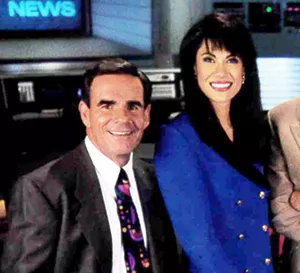
Channel 12 publicity photo featuring erstwhile anchors Kent Dana (left) and Lin Sue Cooney (correct).
Lin Sue Cooney
I also remember, to my horror, that all the makeup in my purse melted as I ran around in the heat getting interviews. A agglomeration of expensive lipstick turning into goo.
Kent Dana, onetime news anchor, Channel 12 (KPNX-Telly): [The rut] quickly became the atomic number 82 story. It made the conclusion that day pretty easy considering of the overall effect information technology had on the Valley and what people were doing to deal with it. It was an automatic lead.
Pat McMahon, local histrion/broadcaster/entertainer: When I watched the weather that night on the news and those astonishing numbers came on the screen, I'm sure I shouted out an obscenity of some kind.
Munsey: We were planning to practise certain things about the high temperatures, and all that went out the window once we hit 122. Other affiliates started calling and wanted a live [segment] with me about information technology. When winter was severe in Cleveland, they'd call us and desire to do a contrast story. I did these all the time, unremarkably on the roof of our edifice.
On the style up, I got five interns [and] we worked out a scrap. The about interesting thing was, afterward we got off the air, we had 250 telephone calls from all around the land and not one question nearly the weather. That item day, I had been wearing a pair of leather suspenders, and they were braided. Everyone asked, "Where could I go a pair of suspenders like that?" Not i person asked nearly the weather.
Bob Boze Bell, Arizona historian/writer/artist: Don't kid yourself, our summers are the worst. I've been through more 50 and I can assure y'all it never gets easier. Here's my pecking order for Phoenix survival: 95 degrees is a piece of cake. 105 is uncomfortable, but anything over 110 is nuclear. The 24-hour interval it striking, 122 felt like a meltdown. It hurt to breathe. I'm not kidding.
Marshall Trimble, Arizona's official country historian: I'd been up in the Four Corners area on a field trip with a group of teachers and bout guides from Scottsdale Community College. When I got dwelling that day, the showtime thing I noticed was the heat had turned my swimming pool a vivid greenish-yellowish, and I'd loaded it upward with chemicals before I'd left.
Carvin Jones, local blues guitarist: I was out working a construction job at the [Union Hills water treatment found]. Human, was it hot. Guys were but passing out and ambulances were coming to accept guys away earlier heatstroke got them. Information technology was crazy. Couple of weeks after, I quit and haven't worked another job except playing music ever since.
Curtis Grippe, drummer, Dead Hot Workshop: We were roofing these vacant houses forth [what would become] the Loop 101 freeway in Scottsdale. I place had running h2o, so at the cease of the twenty-four hour period, we hosed off the driveway and laid down in the water because we were just baking.
Mike Gentry, journeyman electrician, Table salt River Projection: We were putting undercover conduit into the trenches at Scottsdale Road and McDowell by the old Ray Korte Chevrolet. The 120 the day before was astounding, then we hitting 2 more degrees. When you're working exterior, at that place wasn't much difference between the 2 temperatures. Both days were absolutely savage. Information technology wasn't fun beingness down in a trench gluing conduit together.

Sitting at a motorcoach stop during Phoenix's hottest 24-hour interval e'er wasn't much fun.
Sophy Smith
Pendland: Getting home from piece of work that day was torture. At the fourth dimension, [Taco Bell] uniforms were fabricated from this polyester that didn't breathe at all. Walking across the blacktop at Paradise Valley Mall was like walking across the surface of the sun and it was fifty-fifty hotter that afternoon. I wound upwards waiting for the passenger vehicle for similar 45 minutes. Past the time I got home, I was an incredible shade of imperial.
Sloane Burwell, Phoenix resident: I'd just moved here from NYC and was living at a friend-of-a-friend's apartment in Tempe. I tried walking over to Mill Avenue to expect into some stupid telemarketing chore. And my anxiety were burning up! Information technology never occurred to me the oestrus would transfer through concrete or my Keds. I discovered some artistic ways to walk on the sidewalk.
Chuck Hall, local blues guitarist: I used to run six miles every afternoon, fifty-fifty in the centre of summer. I was okay for the first couple miles that solar day, and then it started wearing me down. Of a sudden, I literally simply stopped, got a little chilled, and was like, "I can't run some other footstep." All I could do was turn effectually and walk home. I felt strange all night, and when I picked up my guitar I couldn't [play]. It took a few days to get dorsum to what passes for normal.
Donna Durkalec, Phoenix resident: My rock band Where'due south Valentino was supposed to audition for Star Search that mean solar day. We'd sent a tape in prior to that and they'd prepare something at a Tempe studio to meet u.s.a. [live] and talk to us. Nosotros were all set up to play but the guy just couldn't become a aeroplane to Phoenix for some reason. So he never came out and information technology just never happened.
Deborah Reardon, Litchfield Park resident: At the Revco [drugstore] where I was working, i of the outer brick walls was so hot from the sun hitting it on the other side, the makeup hanging on it was starting to cook. Fifty-fifty with the air conditioning on. So nosotros took it all downwardly before information technology fabricated a mess.
Beatrice Moore, local artist: I remember driving effectually downtown Phoenix in my vintage 1960 pink Cadillac with my windows down since the air conditioning wasn't working. It was unbelievably hot and felt similar having a heater smacking you in the face full blast.
Danny Zelisko, longtime concert promoter: A musician was visiting our offices that day from out of town and were out of their minds with how hot it was. I demonstrated cooking eggs on some ceramic tiles that had been outside baking in the sunday all day. And it literally cooked. Didn't take long. Those tiles were definitely hotter than 122.
Hans Olson, blues musician: Things just felt off that day. I was with a few guys from the Phoenix Dejection Social club opening a banking company account on Central Avenue in downtown. At that moment, a car blew its radiator at the intersection where we were standing. So another one blew. I said, "I'm getting the heck outta here. This is too weird."
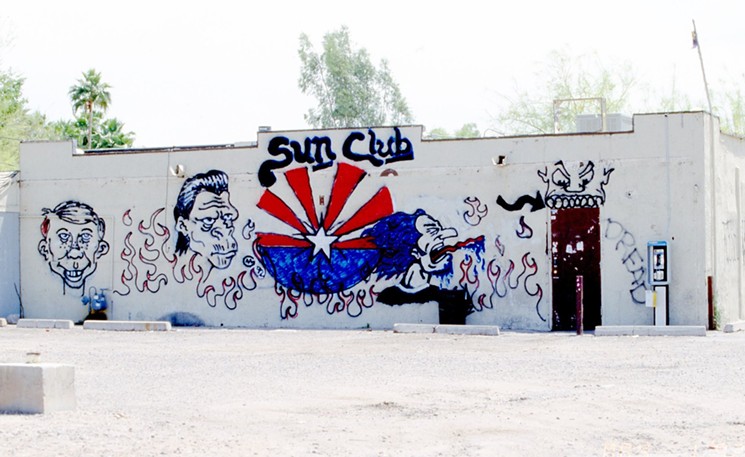
Now-defunct Tempe bar and music venue The Sun Club.
Tempe History Museum
viii p.m., 112 Degrees
The sun went downward, but Phoenix stayed hot that night. Equally nearly residents cooled their heels at home or recovered, others hit the still-smoldering pavement and headed for local confined to drinkable upward, get downwards, and rock out, hot weather be damned.
Michael Vogt, Phoenix resident: It wasn't much of a very different night for me and the people I know. And then information technology was 110, 120 out? Eh, who cares? Subsequently playing tennis at Glendale Customs Higher, nosotros went to [now-defunct bar] Farrah's on Camelback about 43rd Artery and drank, danced, the whole thing. In that location was nothing stopping united states. It was pretty total, like Farrah's normally was in those days. Stayed until x p.m. and came home, but by that time nosotros were so lit, we wouldn't have cared nigh how hot it was.
Guercio: My ring at the time, Local 118, was at [now-defunct Tempe bar] The Sun Club that night. And everyone who played back and then knows the place wasn't air-conditioned, or information technology never really worked. The Sun Club was notorious for this drummer'south apse behind the stage, basically a box cut-out with no air circulating. I'm gasping for air dorsum there drumming, and with the stage lights and the lack of oxygen, telling myself, "Oh God, please don't pass out in the eye of your set." And [late soundman Nino Notaro] was behind the soundboard in this little cave as well. I think saying to him as we loaded out, "I was going to pass out upwards at that place,' and he was similar, "Dude, how practise yous think I feel?"
Dana: I'grand pretty certain I jumped in the puddle after piece of work. That was automated, because when you sit down on the set during a newscast, it's just hot, and y'all become abode, yous don't necessarily want to take a shower, so it was easier to go bound in the pool. I ordinarily got home nigh xi o'clock, and the pool was always nice at that time.
Dana: Whenever we get close, I always hope we don't suspension the record. The number's just stayed in my head all these years.
Selover: Do I call back nosotros're ever going to hitting the tape again or interruption information technology? Aye, because we've gotten close once more and once more: 119 in 2013 and 2017. I'm only kind of surprised it hasn't hit 122 once again. Sometimes it seems more similar a fluke, simply I don't necessarily buy that. I expect we'll ultimately get to that signal once more. It hasn't happened yet, but it will.
Source: https://www.phoenixnewtimes.com/arts/hottest-day-ever-in-phoenix-oral-history-122-degrees-11477223
0 Response to "what happened to the pink sidewalk in phoenix arizona"
Postar um comentário